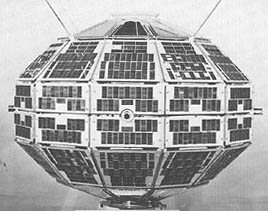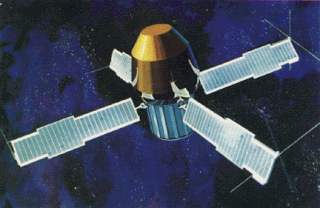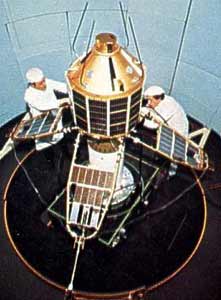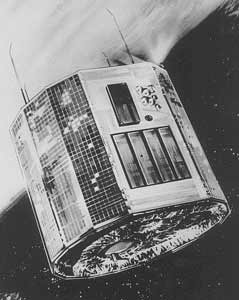
Clementine was a joint space project between the Ballistic Missile Defense Organization and NASA, launched on January 25, 1994. Its objective was to test sensors and spacecraft components in long-term exposure to space and to make scientific observations of both the Moon and the near-Earth asteroid 1620 Geographos. Observation of the asteroid was not made due to a malfunction in the spacecraft.

Alouette 1 is a deactivated Canadian satellite that studied the ionosphere. Launched in 1962, it was Canada's first satellite, and the first satellite constructed by a country other than the Soviet Union or the United States. Canada was the fourth country to operate a satellite, as the British Ariel 1, constructed in the United States by NASA, preceded Alouette 1 by five months. The name "Alouette" came from the French for "skylark" and the French-Canadian folk song of the same name.

The Prospero satellite, also known as the X-3, was launched by the United Kingdom in 1971. It was designed to undertake a series of experiments to study the effects of space environment on communications satellites and remained operational until 1973, after which it was contacted annually for over 25 years. Although Prospero was the first British satellite to have been launched successfully by a British rocket, the first British satellite placed in orbit was Ariel 1, launched in April 1962 on a U.S. rocket.

The Rossi X-ray Timing Explorer (RXTE) was a satellite that observed the time variation of astronomical X-ray sources, named after physicist Bruno Rossi. The RXTE had three instruments—an All Sky Monitor, the Proportional Counter Array, and the High-Energy X-ray Timing Experiment (HEXTE). The RXTE observed X-rays from black holes, neutron stars, X-ray pulsars and X-ray bursts. It was funded as part of the Explorer program, and is sometimes also called Explorer 69.

Aryabhata was India's first satellite, named after the famous Indian astronomer. It was launched on 19 April 1975 from Kapustin Yar, a Russian rocket launch and development site in Astrakhan Oblast using a Kosmos-3M launch vehicle. It was built by the ISRO.

Spaceflight began in the 20th century following theoretical and practical breakthroughs by Konstantin Tsiolkovsky and Robert H. Goddard. The Soviet Union took the lead in the post-war Space Race, launching the first satellite, the first man and the first woman into orbit. The United States caught up with, and then passed, their Soviet rivals during the mid-1960s, landing the first man on the Moon in 1969. In the same period, France, the United Kingdom, Japan and China were concurrently developing more limited launch capabilities.

Satellite Instructional Television Experiment or SITE was an experimental satellite communications project launched in India in 1975, designed jointly by NASA and the Indian Space Research Organization (ISRO). The project made available informational television programs to rural India. The main objectives of the experiment were to educate the financially backward and academically illiterate people of India on various issues via satellite broadcasting, and also to help India gain technical experience in the field of satellite communications.

The Small Astronomy Satellite 2, also known also as SAS-2, SAS B or Explorer 48, was a NASA gamma ray telescope. It was launched on 15 November 1972 into the low Earth orbit with a periapsis of 443 km and an apoapsis of 632 km. It completed its observations on 8 June 1973.

Ariel 3 was a satellite in the Ariel programme, a satellite partnership between the US and UK. Three of the onboard experiments continued research from the first two missions and two experiments were designed for new research topics. It was launched from Vandenberg Air Force Base on 5 May 1967, making it the first satellite of the program to launch from the West coast. Ariel 3 was shut down in September 1969, and re-entered the Earth's atmosphere 14 December 1970.
Ariel was a British satellite research programme conducted between the early 1960s and 1980s. Six satellites were launched as part of the programme, starting with the first British satellite, Ariel 1, which was launched on 26 April 1962, and concluding with the launch of Ariel 6 on 2 June 1979. The launch of Ariel 1 made Britain the third country to have a satellite orbiting the Earth. The first four were devoted to studying the ionosphere, the remaining two to X-ray astronomy and cosmic-ray studies.

OSO 7 or Orbiting Solar Observatory 7, before launch known as OSO H is the seventh in the series of American Orbiting Solar Observatory satellites launched by NASA between 1962 and 1975. OSO 7 was launched from Cape Kennedy on 29 September 1971 by a Delta N rocket into a 33.1° inclination, low-Earth orbit, and re-entered the Earth's atmosphere on 9 July 1974. It was built by the Ball Brothers Research Corporation (BBRC), now known as Ball Aerospace, in Boulder Colorado.

Ariel 6, known pre-launch as UK-6, was a British and American satellite launched in 1979 as part of the Ariel programme. It was operated by the Science Research Council, which became the Science and Engineering Research Council in 1981. Ariel 6 was used for astronomical research and provided data until February 1982. It was the last Ariel satellite to be launched.

Ariel 1, was the first British satellite, and the first satellite in the Ariel programme. Its launch in 1962 made the United Kingdom the third country to operate a satellite, after the Soviet Union and the United States. It was constructed in both the UK and the United States by NASA Goddard Space Flight Center and SERC, under an agreement reached as the result of political discussions in 1959 and 1960. The US Starfish Prime high-altitude nuclear test affected Ariel 1's operational capability.

Ariel 2, also known as UK-C, was a British radio astronomy satellite, which was operated by the Science and Engineering Research Council as part of the Ariel programme. It was built in America by Westinghouse Electric, and had a mass at launch of 68 kilograms (150 lb). It was launched in 1964, and became the first satellite to be used for radio astronomy, although the Canadian satellite Alouette 1 was launched 1962 and also did similar radio astronomy observations.

Ariel 4, known pre-launch as UK 4, was a British ionospheric research satellite, which was operated by the Science and Engineering Research Council. It was launched 11 December 1971, aboard an American Scout rocket. Experiments were designed to meet one scientific objective, making it the first mission-oriented satellite for the UK. It was also the first satellite in the Ariel programme to contain an American experiment. Ariel 4 decayed from orbit on 12 December 1978
Henry (Harry) Elliot, was a British space scientist, and Emeritus Professor of Physics, at the University of London.

Robert Eugene Bourdeau was an American physicist known for major contributions to the study of the ionosphere, plasma physics and radio science using space vehicles including satellites and rockets. Among his many achievements was the launch on November 3, 1960 of Explorer 8 from Cape Canaveral, Florida. This occurred during his 16-year career at the National Aeronautics and Space Administration (NASA). He was both Project Manager and Project Scientist for Explorer 8 which added significant knowledge to the understanding of these fields.
The German space programme is the set of projects funded by the government of Germany for the exploration and utilisation of outer space. The space programme is run by the German Aerospace Center, who conduct research, plan, and implement the programme on behalf of the German federal government.















